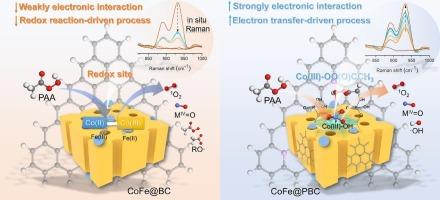磷掺杂诱导的电子转移促进过氧乙酸的钴铁生物炭活化:农药降解的选择性反应物质生成
IF 13.2
1区 工程技术
Q1 ENGINEERING, CHEMICAL
引用次数: 0
摘要
本研究采用磷(P)掺杂改性废生物质钴铁生物炭的固有结构,从而提高其活化过氧乙酸(PAA)的效率。p掺杂钴铁生物炭活化PAA对各种有机氯农药的降解效率显著提高,提高幅度约为1.53 ~ 5.98倍。与钴铁生物炭/PAA体系相比,农药的降解主要归因于催化剂-PAA配合物的形成,而不是金属间氧化还原反应。通过实验分析和理论计算,确定了Co、Fe和P的协同效应,并将其总结为:1)高孔结构的形成和P的形态增强了PAA和农药在催化剂表面的吸附;ii) P原子增强碳层的反应性,进一步调节Co位对PAA的固存能力,从而促进≡Co(III) -OO (O)CCH3的形成;iii) P掺杂促进了催化剂和PAA之间的电子转移,使得催化剂-PAA配合物和高价金属-氧的有序生成成为可能。本研究深入阐明了杂原子(P)在典型过渡金属-碳基催化剂对PAA活化的协同调节作用。本文章由计算机程序翻译,如有差异,请以英文原文为准。

Phosphorus doping-induced electron transfer promotes cobalt-iron biochar activation of peracetic acid: Selective reactive substance generation for pesticide degradation
This study employed phosphorus (P) doping to modify the intrinsic structure of cobalt-iron biochar derived from waste biomass, thereby enhancing its efficacy in activating peracetic acid (PAA). The degradation efficiencies of P-doped cobalt-iron biochar-activated PAA for various organochlorine pesticides were significantly improved, with enhancements ranging from approximately 1.53 to 5.98 times. In comparison to the cobalt-iron biochar/PAA system, the degradation of pesticide was primarily attributed to the formation of catalyst-PAA complexes, rather than intermetallic redox reactions. Based on both experimental analyses and theoretical calculations, the synergistic effects of Co, Fe, and P are identified and summarized as follows: i) the formation of a highly porous structure and P species enhances the adsorption of PAA and pesticides onto the catalyst surface; ii) P atoms enhance the reactivity of the carbon layer and further regulate the ability of Co sites to sequester PAA, thereby promoting the formation of ≡Co(III)–OO(O)CCH3; iii) P doping facilitates electron transfer between the catalyst and PAA, enabling the sequential generation of catalyst-PAA complexes and high-valent metal–oxygen species. This study thoroughly elucidates the synergistic role of heteroatoms (P) in modulating the activation of PAA by typical transition metal–carbon-based catalysts.
求助全文
通过发布文献求助,成功后即可免费获取论文全文。
去求助
来源期刊

Chemical Engineering Journal
工程技术-工程:化工
CiteScore
21.70
自引率
9.30%
发文量
6781
审稿时长
2.4 months
期刊介绍:
The Chemical Engineering Journal is an international research journal that invites contributions of original and novel fundamental research. It aims to provide an international platform for presenting original fundamental research, interpretative reviews, and discussions on new developments in chemical engineering. The journal welcomes papers that describe novel theory and its practical application, as well as those that demonstrate the transfer of techniques from other disciplines. It also welcomes reports on carefully conducted experimental work that is soundly interpreted. The main focus of the journal is on original and rigorous research results that have broad significance. The Catalysis section within the Chemical Engineering Journal focuses specifically on Experimental and Theoretical studies in the fields of heterogeneous catalysis, molecular catalysis, and biocatalysis. These studies have industrial impact on various sectors such as chemicals, energy, materials, foods, healthcare, and environmental protection.
 求助内容:
求助内容: 应助结果提醒方式:
应助结果提醒方式:


